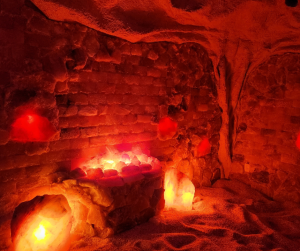Uncovering Common Issues in Modern Salt Rooms - Insights from a True Pioneer
Dr. Margaret Smiechowski’s New Guide Exposes What’s Missing in Today’s Trendy Salt Rooms
“Salt therapy originates from natural salt mines and caves—places with large quantities of salt,” explains Dr. Smiechowski. “The same principle must apply to simulated salt caves. That means four walls covered with salt, and a climate-controlled environment designed to mimic the natural cave conditions.”
One of the biggest misconceptions is that salt on the walls isn’t necessary. In truth, it’s foundational. The walls, climate control, and the use of a calibrated salt generator all work in tandem to provide authentic and effective salt therapy. Without this balance, the space might resemble a salt room, but it won’t offer the same benefits.
Dr. Margaret warns that many people are building salt rooms without truly understanding how these three critical elements—salt coverage, climate control, and proper salt dispersion—must work together. Improperly designed salt rooms can not only be ineffective but also pose safety risks. For example, ceiling air-conditioning grills may seem harmless, but they can disrupt the salt concentration and push salt into the walls, potentially creating a fire hazard.
“Many people think more salt in the air is better, but if you come out of a session dusted in salt, that’s a red flag,” Dr. Margaret adds. “That means the salt levels are too high and the system isn’t calibrated correctly. Halotherapy is all about balance—too much can be just as ineffective as too little.”
Before booking a salt therapy session, Dr. Margaret recommends that consumers do some homework. Look for the signs of a poorly built salt room:
No salt or very little salt on the walls
Drop ceiling, windows, or two doors in the room.
No ADA accessibility
AC vents or grills in the ceiling
Fabric pillows or furniture
Household lighting, stick or wood branches for decorations
Visible rope lights behind salt walls
Dust on clothing after a session
A generally unprofessional appearance
These are some indicators that a salt room may not meet therapeutic standards, as Dr. Margaret says, “If you’re going to invest in your wellness, make sure you’re getting the therapy you’re paying for.”
If you're considering building a salt room or are unsure whether your current space is up to par, Dr. Margaret and her team are here to help. Salt Cave Inc. is the trusted name in halotherapy with a long-standing reputation for excellence and integrity in salt cave construction.
For more information or to learn how to set up a truly healthy and effective salt room, please contact:
Salt Cave Inc.
Alex Miller Keeps Classic Country Flame Burning With Alan Jackson Song 'Secondhand Smoke'
Lala’s Place TV Launches YouTube Channel to Empower, Educate, and Entertain Young Learners Through Music and Animation
leagend RT200: A Professional Lithium Battery Tester Designed for Accurate, Reliable Diagnostics
Kalendarium
Więcej ważnych informacji
 Jedynka Newserii
Jedynka Newserii

 Jedynka Newserii
Jedynka Newserii

Prawo

Trwają dyskusje nad kształtem unijnego budżetu na lata 2028–2034. Mogą być rozbieżności w kwestii Funduszu Spójności czy dopłat dla rolników
Trwają prace nad wieloletnimi unijnymi ramami finansowymi (WRF), które określą priorytety wydatków UE na lata 2028–2034. W maju Parlament Europejski przegłosował rezolucję w sprawie swojego stanowiska w tej sprawie. Postulaty europarlamentarzystów mają zostać uwzględnione we wniosku Komisji Europejskiej w sprawie WRF, który zostanie opublikowany w lipcu 2025 roku. Wciąż jednak nie ma zgody miedzy państwami członkowskimi, m.in. w zakresie Funduszu Spójności czy budżetu na rolnictwo.
Konsument
35 proc. gospodarstw domowych nie stać na zakup mieszkania nawet na kredyt. Pomóc może wsparcie budownictwa społecznego i uwolnienie gruntów pod zabudowę

W Polsce co roku oddaje się do użytku ok. 200 tys. mieszkań, co oznacza, że w ciągu dekady teoretycznie potrzeby mieszkaniowe społeczeństwa mogłyby zostać zaspokojone. Jednak większość lokali budują deweloperzy na sprzedaż, a 35 proc. gospodarstw domowych nie stać na zakup nawet za pomocą kredytu. Jednocześnie ta grupa zarabia za dużo, by korzystać z mieszkania socjalnego i komunalnego. Zdaniem prof. Bartłomieja Marony z UEK zmniejszeniu skali problemu zaradzić może wyłącznie większa skala budownictwa społecznego zamiast wspierania kolejnymi programami zaciągania kredytów.
Problemy społeczne
Hejt w sieci dotyka coraz więcej dzieci w wieku szkolnym. Rzadko mówią o tym dorosłym

Coraz większa grupa dzieci zaczyna korzystać z internetu już w wieku siedmiu–ośmiu lat – wynika z raportu NASK „Nastolatki 3.0”. Wtedy też stykają się po raz pierwszy z hejtem, którego jest coraz więcej w mediach społecznościowych. Według raportu NASK ponad 2/3 młodych internautów uważa, że mowa nienawiści jest największym problemem w sieci. Co więcej, dzieci rzadko mówią o takich incydentach dorosłym, dlatego tym istotniejsze są narzędzia technologiczne służące ochronie najmłodszych.
Partner serwisu
Szkolenia

Akademia Newserii
Akademia Newserii to projekt, w ramach którego najlepsi polscy dziennikarze biznesowi, giełdowi oraz lifestylowi, a także szkoleniowcy z wieloletnim doświadczeniem dzielą się swoją wiedzą nt. pracy z mediami.










.gif)

 |
| |
| |
|